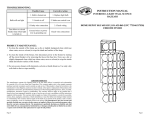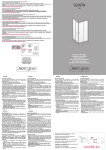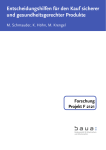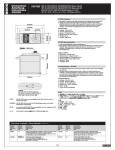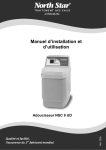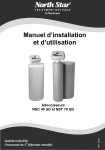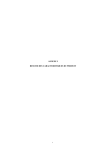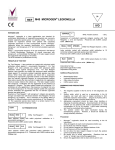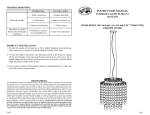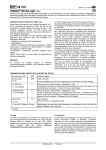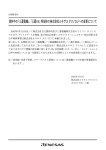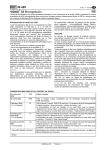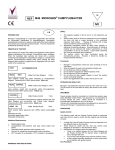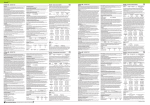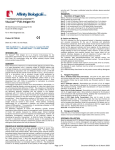Download Coamatic Protein S-Free 82400363 - Medica-Tec
Transcript
COAMATIC® Protein S-Free - 82 4003 63 ENGLISH - Insert revision 04/2010 Automated latex ligand immunoassay for the quantitative determination of free Protein S (PS) in human citrated plasma on automated instruments. Make sure of the complete reconstitution of the product. It must appear as a homogenous and slightly milky suspension. Keep the reagent at 15-25°C for 30 minutes and invert to mix before use. Do not shake. Anti PS MAb Latex: Invert to mix before to use. Do not shake and AVOID FOAM FORMATION. Background and summary Storage condition and stability Protein S is a vitamin K-dependent cofactor for the anticoagulant and the profibrinolytic effects of activated Protein C.1 Two forms of Protein S are present in plasma: free Protein S (40%), and Protein S linked to the complement C4b-binding protein (C4BP) (60%). Only free Protein S has functional cofactor activity.2 Protein S deficiency may be hereditary3 or acquired. Acquired deficiency may be observed during pregnancy, oral anticoagulant therapy, oral contraceptive use, in liver disease, in newborn infants as well as in other clinical conditions.4,5,6 Deficiency of Protein S has been associated with a high risk of developing venous thromboembolism especially in young people.7,8 Unopened reagents are stable until the expiration date shown on the vial when stored at 2-8°C. C4BP Latex - Stability after reconstitution: 1 month at 2-8°C in the original vial. Do not freeze. Anti PS MAb Latex - Opened reagent is stable 1 month at 2-8°C. Do not freeze. For optimal stability remove reagents from the system and store them at 2-8°C in the original vial. Intended use Measurament principle The COAMATIC® Protein S-Free assay determines the presence of free Protein S by measuring the increase of turbidity produced by the agglutination of two latex reagents. Purified C4BP adsorbed onto the first latex reagent reacts with a high affinity for free Protein S of patient plasma in the presence of Ca2+ ions. 9,10 The free Protein S adsorbed on the C4BP latex triggers the agglutination reaction with the second latex reagent, which is sensitized with a monoclonal antibody directed against human Protein S. The degree of agglutination will be directly proportional to the free Protein S concentration in the test sample. Reagents The COAMATIC® Protein S-Free kit consists of: C4BP Buffer: 3 vials of Borax buffer containing bovine serum albumin, stabilizers and preservative. C4BP Latex: 3 vials of a lyophilized suspension of polystyrene latex particles coated with purified human C4BP containing bovine serum albumin, stabilizers and preservative. Anti PS MAb Latex: 3 vials of a suspension of polystyrene latex particles coated with a monoclonal antibody directed against human Protein S containing bovine serum albumin, stabilizers and preservative. CAUTION: The material in this product was tested by FDA approved test methods and found nonreactive for Hepatitis B Surface Antigen (HBsAg), Anti-HCV and HIV 1/2 antibodies. Handle as if potentially infectious.11 PRECAUTIONS AND WARNINGS: Avoid contact with skin and eyes (S24/25). Do not empty into drains (S29). Wear suitable protective clothing (S36). This product is for in vitro diagnostic use. Reagent required but not provided 1. Calibration plasma 2. Abnormal control plasma Level 1/2 3. Saline (0.9% NaCl) Art No 82 3534 63 Art No 82 3559 63 Reagent preparation C4BP Buffer: The reagent is ready for use. C4BP Latex: Dissolve the contents of each vial of C4BP latex by pouring the entire contents of one vial of C4BP buffer into the latex reagent vial. Replace the stopper and swirl gently for a minimum of 20 seconds to completely dissolve the lyophilized latex. Specimen collection and preparation Nine parts of freshly drawn venous blood are collected into one part trisodium citrate. Refer to NCCLS Document H21-A3 for further instructions on specimen collection, handling and storage.12 Frozen plasma samples should be rapidly thawed at 37°C while gently mixing before testing. After thawing the assay must be performed within 2 hours. Quality control Normal and abnormal controls are recommended for a complete quality control program.13 Abnormal control plasma Level 1/2 Art No 82 3559 63 are designed for this program. The assigned values of these Controls are traceable to the International Standard. Each laboratory should establish its own mean and standard deviation and should establish a quality control program to monitor laboratory testing. Controls should be analyzed at least once every 8 hour shift in accordance to good laboratory practice. Refer to the instrument’s Operator’s Manual for additional information. Refer to Westgard et al for identification and resolution of out-of-control situtations.14 Results Free Protein S results are reported in % normality. The assay results should be used with other information, including the clinical context, in forming a diagnosis. Limitations/interfering substances Free Protein S results are not affected by heparin (UF heparin or LMW heparin) up to 1.5 IU/mL, bilirubin up to 18 mg/dL, hemoglobin up to 200 mg/dL, lipids up to 1280 mg/dL, platelets up to 1011/L and rheumatoid factor up to 350 IU/mL. Hemolyzed and turbid samples should not be assayed. COAMATIC® Protein S-Free assay is not affected by Factor V Leiden mutation (APC-R). Reference values Procedures All conditions included in this package insert are referred to ACL Futura. Detailed instrument application setting including instructions for preparation of the reagents for a variety of automated instruments are available on request from Chromogenix. Calculation The changes in absorbance for the standards are plotted against free Protein S %. The samples results are then calculated from the linear equation obtained from the standard curve. This procedure is automatically handled by the instruments. Performance characteristics Precision: Within run precision was assessed over multiple runs. ACL Futura CV% (Within run) CV% (Between run) Mean (%FPS) 97.7 (n=60) 1.9 0.8 57.0 (n=60) 2.7 1.1 22.4 (n=60) 2.9 1.0 Correlation: System slope intercept r Comparative method ACL Futura 0.918 2.32 0.981 Free Protein S EIA ACL 9000 0.933 5.09 0.972 Free Protein S EIA The precision and correlation results were obtained using specific lots of reagents and controls. Linearity: System ACL Futura 12 - 135 (% Free Protein S) Sample results above 135% should be manually diluted 1:2 with saline (200 μL of sample + 200 μL of saline) and reassayed. The printed results must be multiplied by 2 to correct for the dilution. Detection Limity: System ACL Futura: 6.4 % Free Protein S Determinations/Kit On ACL Futura 75 tests (approx.) A normal range study was performed using the COAMATIC® Protein S-Free kit on ACL Futura. Sex N ACL Futura % fFree PS Male 130 64.4 - 128.8 *Female 102 53.2 - 109.1 * Note: Age and hormonal status may affect the normal range for females.15 Ranges were calculated as recommended by the International Federation of Clinical Chemistry (IFCC).16 These results were obtained using a specific lot of reagent. Due to many variables, which may affect results, each laboratory should establish its own free Protein S normal range. Calibration A standard curve is obtained by analyzing different dilutions of Calibration Plasma Art. No 82 3534 63 in saline, which should be traceable to the International Standard. COAMATIC® Protein S-Free - 82 4003 63 DEUTSCH - Beipackzettel Version 04/2010 Verwendugszweck Lösen der reagenzien Rererenzwerte Vollautomatischer Latex-Immunoassay zur quantitativen Bestimmung des freien Protein S im menschlichen Plasma. C4BP Buffer: Gebrauchsfertig. C4BP Latex: Der Inhalt einer Flasche C4BP Latex wird durch Hinzugabe des ganzen Inhalts einer Flasche C4BP Puffer (4 mL) gelöst. Das Reagenz sollte für mindestens 20 Sekunden vorsichtig geschwenkt werden um das lyophilisierte Latex komplett zu lösen und eine homogene und leicht milchige Suspension zu erhalten. Nach vollständiger Rekonstitution wird das Reagenz 30 Minuten bei 15-25°C inkubiert und dann unter vorsichtigem Schwenken erneut gemischt. Nicht schütteln. Anti PS MAb Latex: Vor dem Gebrauch vorsichtig schwenken. Nicht schütteln, SCHAUMBILDUNG VERMEIDEN. Mit dem COAMATIC® Protein S-Freies Kit wurde eine Studie zur Bestimmung des Normalbereichs durchgeführt. Geschlecht N ACL Futura % Freies PS Männer 130 64,4 - 128,8 *Frauen 102 53,2 - 109,1 * Hinweis: Der Normalbereich für Frauen kann vom Alter und hormonellen Status beeinflußt werden. Die Bereiche wurden gemäß den Vorschriften der “International Federation of Clinical Chemistry (IFCC)” berechnet.16 Die Ergebnisse sind mit einer spezifischen Reagenziencharge ermittelt worden. Aufgrund verschiedener Variablen, die die Testergebnisse beeinflussen können, wird empfohlen, daß jedes Labor seinen eigenen Normalbereich für das Freie Protein S ermittelt. Grundlagen und Zusammenfassung Protein S ist ein Vitamin K-abhängiger Kofaktor für die antikoagulatorischen und profibrinolytischen Effekte von aktiviertem Protein C.1 Es liegt im Plasma in zwei Formen vor: zu 40% als Freies Protein S und zu 60 % in gebundener Form an C4b-Bindeprotein (Komplementfaktor). Die beiden Formen stehen in einem dynamischen Gleichgewicht. Nur das freie Protein S ist biologisch aktiv.2 Ein Protein S Mangel kann sowohl angeboren3 als auch erworben sein. Erworbene Mangelzustände können während der Schwangerschaft, unter oraler Antikoagulantientherapie, bei Einnahme oraler Kontrazeptiva, bei Lebererkrankungen, bei Neugeborenen und bei anderen klinischen Zuständen auftreten.4,5,6 Protein S-Mangel ist als Risikofaktor bekannt, der die Bildung von venösen Thrombosen besonders bei jungen Patienten begünstigt.7,8 Testprinzip Beim COAMATIC® Protein S-Freies wird der Gehalt an Freiem Protein S über die Messung der Trübungszunahme, die durch die Agglutination der beiden Latexreagenzien entsteht, bestimmt. Die mit C4BP beschichteten Latexpartikel haben eine große Affinität für das freie Protein S im Patientenplasma so dass in Gegenwart von Ca2+ Ionen das freie Protein S vom spezifischen Liganden C4BP gebunden wird.9,10 In einem zweiten Schritt wird ein ebenfalls an Latexpartikel gebundener monoklonaler anti-Protein S Antikörper zugegeben. Diese Latexpartikel binden über eine Antigen-Antikörper-Reaktion unter Ausbildung von Immunkomplexen an das bereits gebundene Protein S der ersten Reaktion. Der Agglutinationsgrad ist direkt proportional zur Konzentration des Freien Protein S in der Probe. Reagenzien C4BP Buffer: 3 Fläschchen mit Borax-Puffer, der bovines Serum-Albumin, Stabilisatoren und Konservierungsmittel enthält. C4BP Latex: 3 Fläschchen lyophilisierte Suspension aus Polystyrol-Latexpartikeln, die mit gereinigtem humanen C4BP beschichtet sind. Sie enthalten zusätzlich bovines Serum-Albumin, Stabilisatoren und Konservierungsmittel. Anti PS MAb Latex: 3 Fläschchen Suspension aus Polystyrol-Latexpartikeln, die mit monoklonalen anti-Protein S Antikörpern beschichtet sind. Sie enthalten zusätzlich bovines Serum-Albumin, Stabilisatoren und Konservierungsmittel. ACHTUNG: Das verwendete Material wurde mit FDA anerkannten Testmethoden auf HIV-Antikörper, Hepatitis-B-Antigen und HCV-Antigen geprüft. Bitte beachten Sie die Bestimmungen zum Umgang mit potentiell infektiösen Materialien.11 ACHTUNG: INFEKTIONSRISIKO Berührung mit den Augen und der Haut vermeiden (S24/25). Nicht in die Kanalisation gelangen lassen (S 29). Bei der Arbeit geeignete Schutzkleidung tragen (S36). Dieses Produkt ist nur für die in vitro Diagnostik geeignet. Zusätzlich benötigte nicht kit enthalten 1. Kalibrationsplasma 2. Abnormal-Kontroll-Plasma für chromogen Substrattests Bereich 1/2 3. Physiologische kochsalzolösung (0.9% NaCl) Art No 82 3534 63 Art No 82 3559 63 Lagerung und haltbarkeit Die ungeöffneten Reagenzien sind bei Lagerung zwischen 2-8°C bis zu dem auf dem Etikett angegebenen Verfallsdatum haltbar. C4BP Latex: Haltbarkeit nach Rekonstitution: bei 2-8°C in der Originalflasche: 1 Monat. Nicht einfrieren. Anti PS MAb Latex - Geöffnetes Reagenz: bei 2-8°C: 1 Monat. Nicht einfrieren. Für eine optimale Haltbarkeit sollten die Reagenzien nach dem Gebrauch aus dem Gerät entnommen und im Kühlschrank bei 2-8°C in der Originalflasche aufbewahrt werden. Probengewinnung 9 Teile frisches venöses Blut und 1 Teil Trinatriumcitratlösung (3,2 %) werden sorgfältig in einem silikonisierten Glasröhrchen gemischt. Hinweise zur Aufbereitung des Blutes sind den Empfehlungen des Deutschen Instituts für Normung - DIN 58 905 - zu entnehmen.12 Eingefrorene Plasmen sollten bei 37°C schnell aufgetaut und vor der Analyse leicht geschwenkt werden. Aufgetaute Proben müssen innerhalb von 2 Stunden analysiert werden. Kalibration Eine Standardkurve wird durch Messung von verschiedenen Verdünnungen eines Kalibrationsplasmas Art No 82 3534 63 mit physiologische Kochsalzlösung (Saline) erstellt. Der angegebene Wert des Kalibrationsplasmas sollte auf den Internationalen Standard zurückzuführen sein. Testdurchführung Alle Bedingungen beigefügt in diesem Insert beziehen sich auf ACL Futura. Spezielle Automatenadaptionen sind auf Anfrange bei Chromogenix. Ergebnisse Extinktionsänderungen (DE) der Standardproben gegen die entsprechende Freies Protein S % auftragen. Die unbekannten Propen werden anhand dieser linearen Standardkurve berechnet. Diese Berechnung wird automatisch durch die Analysgeräte erstellt. Qualitätskontrolle Testeigenschaften Es ist gängige Laborpraxis, die Qualität der Analyse mit Kontrollmaterialien im normalen sowie im pathologischen Bereich zu überprüfen.13 Es wird empfohlen, als Abnormal-Kontroll-Plasma Bereich 1/2 Art No 82 35 59 zu verwenden. Die angegebenen Werte der Kontrollen sollten auf Internationale Standards zurückzuführen sein. Die Bereiche sind der jeweiligen Packungsbeilage zu entnehmen. Jedes Labor sollte jedoch für das Qualitätskontroll-Programm seinen eigenen Mittelwert ± 2 Standardabweichung (s) ermitteln. Spätestens nach jeweils 8 Stunden sollte eine Qualitätskontrolle durchgeführt werden. Algorithmen zur Beurteilung der Qualitätskontrollergebnisse siehe z.B. Westgard et al.14 Präzision Die Präzision im Lauf wurde bei mehreren Läufen bestimmt. ACL Futura VK% (innerhalb der Testserie) VK% (zwischen Testserien) Mittelwert (% FPS) 97.7 (n=60) 1.9 0.8 57.0 (n=60) 2.7 1.1 22.4 (n=60) 2.9 1.0 Korrelation: System Steigung Ordinatenabschnitt r Vergleichsmethode ACL Futura 0,918 2,32 0,981 Freies Protein S EIA Die Ergebnisse sind mit spezifischen Reagenzien- und Kontrollchargen ermittelt worden. Linearität: System ACL Futura 12 - 135 (% Freies Protein S) Testergebnisse über 135 % sollten manuell 1:2 mit Faktordiluent (200 mL Plasma + 200 mL Faktordiluent) verdünnt und nochmals gemessen werden. Anschließend müssen die erhaltenen Ergebnisse, entsprechend der eingesetzten Verdünnung, mit 2 multipliziert werden. Untere Nachweisgrenze System ACL Futura: 6.4 % Freies Protein S Resultates Ergebnisse des Freien Protein Tests werden in Prozent der Norm dargestellt. Sie sollten bei der Diagnosestellung immer im Zusammenhang mit weiteren Informationen, wie z.B. dem klinischen Kontext, herangezogen werden. Weitere Informationen sind dem Bedienerhandbuch zu entnehmen. Grenzen des verfahrens/interferenzen Die Ergebnisse werden durch Konzentrationen an Heparin (unfraktionierte oder niedermolekulare Heparine) bis zu 1,5 U/mL, Bilirubin bis zu 18 mg/dL, Hämoglobin bis zu 200 mg/dL, Lipiden bis zu 1280 mg/dL, Thrombozyten bis zu 1011/L und Rheumafaktor bis zu 60 IU/ mL nicht beeinflußt. Hämolytische und trübe (z.B. ikterische/lipämische) Proben sollten nicht analysiert werden. Der COAMATIC® Protein S-Freies wird durch die Faktor V Leiden Mutation (APC-R) nicht beeinflußt. Anzahi der bestimmungen/kit Proben auf ACL Futura - 75 Proben (etwa) COAMATIC® Protein S-Free - 82 4003 63 Uso recomendado del kit Ligando-inmunoensayo automatizado para la determinación cuantitativa de Proteína S (PS) libre en plasma humano citratado por turbidimetría de partículas de látex. Antecedentes y resumen La Proteína S es un cofactor dependiente de la vitamina K que interviene en los procesos anticoagulantes y profibrinolíticos de la Proteína C activada.1 La Proteína S está presente en el plasma en dos formas: Proteína S libre (40%) y Proteína S ligada a la proteína transportadora de la fracción C4b del complemento (C4BP) (60%). Sólo la Proteína S libre tiene actividad funcional como cofactor.2 La deficiencia en Proteína S puede ser hereditaria3 o adquirida. La deficiencia adquirida se puede observar durante el embarazo, terapia anticoagulante oral, uso de anticonceptivos orales, en enfermedades hepáticas, en neonatos, así como en otras situaciones clínicas.4,5,6 La deficiencia en Proteína S se ha asociado a un alto riesgo de desarrollar tromboembolismo venoso, especialmente en gente joven.7,8 Principio de la determinación El COMATIC® Proteína S-Libre determina la presencia de Proteína S libre midiendo el incremento de turbidez debido a la aglutinación de dos reactivos de látex. La C4BP adsorbida sobre el primer reactivo de látex reacciona con una alta afinidad con la Proteína S libre del plasma del paciente, en presencia de iones Ca2+. 9,10 La Proteína S libre unida a la C4BP del látex provoca la aglutinación del segundo reactivo de látex, el cual está recubierto con un anticuerpo monoclonal dirigido contra la Proteína S humana. El grado de aglutinación será directamente proporcional a la concentración de Proteína S libre en el plasma problema. Reactivos El kit COALIZA® Proteína S-Libre consiste en: C4BP Buffer: 3 viales de tampón Borax que contiene albúmina de suero bovino, estabilizantes y conservante. Látex C4BP: 3 viales de una suspensión liofilizada de partículas de látex de poliestireno a las que se les ha unido C4BP humana purificada. Contiene albúmina de suero bovino, estabilizantes y conservante. Anti PS MAb Latex: 3 viales de una suspensión de partículas de látex de poliestireno a las que se les ha unido un anticuerpo monoclonal específico contra la Proteína S humana. Contiene albúmina de suero bovino, estabilizantes y conservante. ATENCIÓN: El material usado en este producto ha sido analizado por un método aprobado por la FDA y encontrado no reactivo al Antígeno de Superficie de la Hepatitis B (HBsAg), a los anticuerpos anti-HCV y anti-HIV 1/2. Manejar con precaución como si fuese potencialmente infeccioso.11 ADVERTENCIAS Y PRECAUCIONES: Evítese el contacto con los ojos y la piel (S 24/25). No tirar los residuos por el desagüe (S 29). Usen indumentaria protectora adecuada (S 36). Este reactivo es sólo para uso diagnóstico in vitro. Reactivos necessarios pero no suministrados 1. Plasma de calibración 2. Plasma control cromogénico anormal Nivel 1/2 3. Solución salina (0.9 NaCl) Art. No 82 3534 63 Art. No 82 3559 63 Preparación de los reactivos C4BP Buffer: El reactivo está listo para su uso. Látex C4BP: Disolver el contenido de cada vial de látex C4BP vertiendo sobre el mismo todo el contenido del vial de tampón C4BP. Tapar el vial y homogeneizar suavemente un mínimo de 20 segundos. Asegurarse de la completa disolución del producto. Debe aparecer como una ESPAÑOL - Revisión Prospecto 04/2010 supensión homogénea y ligeramente lechosa. Mantener el reactivo entre 15-25°C durante 30 minutos. Mezclar por inversión del vial antes de su uso. No agitar. Anti PS MAb Latex: Mezclar por inversión del vial. No agitar, y EVITAR LA FORMACIÓN DE BURBUJAS. Calibración Condiciones de conservación y estabilidad Procedimiento Los viales que no hayan sido abiertos y se hayan conservado a 2-8°C son estables hasta la fecha de caducidad indicada en la etiqueta. Látex C4BP: Estabilidad una vez reconstituido: 1 mes a 2-8°C en el vial original. No congelar. Anti PS MAb Latex: El reactivo, una vez abierto, es estable 1 mes a 2-8°C. No congelar. Para una óptima estabilidad sacar los reactivos de los instrumentos y conservarlos a 2-8°C en sus viales originales bien tapados. Todas los comentarios incluidos en este inserto son refereidos al ACL Futura. Chromogenix tiene a disposición sobre pedido los ajustes detallados para diversos instrumentos. Incluyendo las instruciones para la preparación de los reactivos para una amplia variedad de instrumentos automáticos. Obtencion de las muestras Recoger nueve partes de sangre recién extraída por punción venosa sobre una parte de anticoagulante citrato trisódico. Para la recolección, manejo y conservación del plasma seguir las recomendaciones del Documento H21-A3 de la NCCLS.12 Los plasmas congelados deben descongelarse rápidamente a 37°C y agitarse bien antes de su análisis. Se debe realizar el ensayo de los mismos antes de transcurridas 2 horas de su descongelación. Control de calidad Para realizar un programa completo de control de calidad, se recomienda el uso de dos niveles de control, controles normal y patológico.13 El plasma anormal Nivel 1/2 cumplen con los requisitos del programa. Los valores asignados para cada nivel de control deben ser referenciados respecto a un valor Estándar nternacional. Cada laboratorio debe establecer su propia media y desviación estándar, y debe realizar un programa de control de calidad para monitorizar sus resultados. Los controles deben ser analizados como mínimo una vez por cada turno de 8 horas, de acuerdo con la normativa de Buenas Prácticas del Laboratorio. El Manual del Usuario contiene información adicional. Consultar la publicación de Westgard et al para la identificación y resolución de situaciones anormales del control de calidad.14 Resultados Los resultados de Proteína S libre se informan en % de normalidad. Para establecer un correcto diagnóstico, los resultados del análisis deben ser usados conjuntamente con el resto de información, incluyendo el contexto clínico. Limitaciones/factores de interferencia Concentraciones de Heparina (heparina estándar y de bajo peso molecular) hasta 1,5 UI/mL, de bilirrubina hasta 18 mg/dL, de hemoglobina hasta 200 mg/dL, de lípidos hasta 1280 mg/dL, de plaquetas hasta 1011/L y de factor reumatoide hasta 350 UI/mL no afectan los resultados de Proteína S libre. No se deben usar muestras turbias o hemolizadas. El kit COMATIC® Proteína S Libre no se ve afectado por la mutación del Factor V Leiden (APC-R). Valores esperados La curva estándar se obtiene analizando distintas diluciones de Plasma de Calibracòn Art No 82 3534 63 en solución salina, el valor del cual debe ser referenciado respecto a un valor Estándar Internacional. Cálculos Trazar la curva del cambio de absorbancia (DA) de las soluciones patrón en función de Proteína S-Libre %. Los resultadod de las muestras se calculan a patir de la ecuación lineal obtenida de la curva estándar. Este proceso es realizado automaticamente por los instrumentos. Características de rendimiento Precisión: La precisión intra-serie se ha determinado después de realizar múltiples series de análisis. ACL Futura CV% (Intra-ensayo) CV%(Total) Media (%FPS ) 97.7 (n=60) 1.9 0.8 57.0 (n=60) 2.7 1.1 22.4 (n=60) 2.9 1.0 Correlación: Sistema Pendiente Intersección r Método de referencia ACL Futura 0,918 2,32 0,981 Proteína S Libre EIA La precisión y los datos de correlación se han obtenido usando lotes específicos de reactivos y de controles. Linealidad: Sistema ACL Futura 12 - 135 (% Proteína S libre) Las muestras que informen resultados por encima del 135% deben diluirse manualmente 1:2 con el Solución salina (200 μL de muestra + 200 μL de Solución salina) y reanalizarse. Los resultados obtenidos deben multiplicarse por el factor de dilución 2. Límite de medición: Sistema ACL Futura: 6.4 % Proteína S libre. Determinaciones/kit Tests en el ACL Futura: 75 tests (approx) Se ha realizado un estudio del rango de normalidad utilizando el kit COMATIC® Proteína S Libre. Sexo N ACL Futura % PS libre Hombre 130 64,4 - 128,8 *Mujer 102 53,2 - 109,1 *Nota: La edad y estado hormonal pueden afectar el rango de normalidad en mujeres.15 Los rangos han sido calculados tal como recomienda la Federación Internacional de Química Clínica (IFCC).16 Estos resultados se han obtenido utilizando un lote específico de reactivo. Debido a las muchas variables que pueden afectar a los resultados, cada laboratorio debe establecer su propio rango de normalidad de Proteína S libre. Instrumentation Laboratory Company - Bedford, MA 01730-2443 (USA) Instrumentation Laboratory SpA - V.le Monza 338 - 20128 Milano (Italy) Distributed by: Instrumentation Laboratory Made in Spain 3800-2952 R4 04/2010 COAMATIC® Protein S-Free - 82 4003 63 FRANÇAIS - Révision de la notice 04/2010 Prevue des trousse Préparation des réactifs Valeurs de references Le réactif COAMATIC® Protéine S-Libre est utilisé pour la détermination quantitative de la Protéine S libre contenue dans le plasma humain citraté. Cette détermination est réalisée par une méthode de dosage immunologique latex. C4BP Buffer: Le réactif est prêt à l’emploi. Látex C4BP: Dissoudre le contenu de chaque flacon de latex C4BP en versant la totalité du contenu d’un flacon de tampon C4BP dans un flacon de réactif latex. Replacer le capuchon et agiter doucement pendant au moins 20 secondes afin d’obtenir la dissolution complète du lyophilisat. Le réactif est totalement reconstitué lorsqu’il se trouve sous forme d’une suspension homogène et légèrement laiteuse. Conserver le réactif à 15-25°C pendant 30 minutes et retourner le flacon pour mélanger le contenu avant utilisation. Ne pas agiter violemment. Anti PS MAb Latex: Réactif prêt à l’emploi. Mélanger par inversion avant utilisation. Ne pas agiter violemment. EVITER LA FORMATION DE MOUSSE. Les valeurs normales de cette étude ont été obtenues en utilisant la trousse Coaliza Protéine S libre. Sexe N ACL Futura % PS libre Masculin 130 64,4 - 128,8 Féminin* 102 53,2 - 109,1 * Note: l’âge et le status hormonal peuvent affecter les valeurs normales chez la femme.15 Les normales ont été calculées comme il est recommandé par l’International Federation of Clinical Chemistry (IFFC).16 Ces résultats sont obtenus en utilisant un lot spécifique de réactif. Du fait qu’un grand nombre de variables peuvent affecter les résultats, nous recommandons à chaque laboratoire d’établir ses propres valeurs normales pour la Protéine S libre. Contexte et resume La Protéine S, protéine vitamine K dépendante, est le cofacteur de la Protéine C activée qui possède un effet anticoagulant et profibrinolytique.1 Deux formes sont présentes dans le plasma: la Protéine S libre (40 %), et la Protéine S liée à la C4b-binding Protein (C4BP) (60 %). Seule la Protéine S libre est biologiquement active.2 Les déficits en Protéine S peuvent être héréditaires3 ou acquis. Les déficits acquis peuvent être observés pendant la grossesse, des traitements anticoagulants oraux, l’utilisation de contraceptifs oraux, dans les maladies hépatiques chez l’enfant nouveau-né ainsi que d’autres conditions cliniques.4,5,6 Les déficits en Protéine S sont associés à un risque élevé de développement d’accidents thromboemboliques veineux particulièrement chez le sujet jeune.7,8 Principe de mesure Le réactif COAMATIC® Protéine S-Libre permet la détermination quantitative de la Protéine S libre en mesurant l’augmentation de la turbidité produite par l’agglutination de particules de latex contenues dans les deux réactifs correspondants. De la C4BP purifiée, adsorbée sur les particules de latex contenues dans le premier réactif, réagit avec la protéine S libre du plasma de patient en présence d’ions Ca2+ 9,10, et ce, avec une très forte affinité. La protéine S ainsi adsorbée sur la C4BP lors de la première réaction se lie à l’anticorps monoclonal anti-protéine S humaine adsorbé sur les particules de latex du second réactif, entraînant une agglutination. Cette dernière est directement proportionnelle à la concentration de La protéine S libre de l’échantillon. Réactifs La trousse COAMATIC® Protéine S-Libre contient: C4BP Buffer: 3 flacons de tampon Borax contenant de l’albumine bovine sérique, des stabilisants et un conservateur. Látex C4BP: 3 flacons d’une suspension lyophilisée de particules de latex polystyrène adsorbées avec de la C4BP humaine, contenant également de l’albumine bovine sérique, des stabilisants et un conservateur. Anti PS MAb Latex: 3 flacons d’une suspension de particules de latex polystyrène adsorbées avec un anticorps monoclonal anti-Protéine S humaine, contenant également de l’albumine bovine sérique, des stabilisants et un conservateur. ATTENTION: Ces réactifs contiennent des produits d’origine humaine. Ils ont été trouvés négatifs pour les anticorps anti VIH 1/2, anti VHC et l’antigène de surface de l’hépatite B (AgHBs), en utilisant des trousses de dépistage de 3ème génération. Cependant, aucune technique ne permettant d’assurer l’absence totale du virus HIV ou de l’hépatite B ou de tout autre agent infectieux, ces réactifs sont à manipuler avec les précautions d’usage.11 ATTENTION: Eviter le contact avec la peau et les yeux (S24/25). Ne pas jeter les résidus à l’égout (S29). Porter un vêtement de protection approprié (S36). Ces produits sont à usage diagnostic in vitro. Réactifs nécessaries mais non fournis 1. Plasma de Calibrage 2. Plasma Contrôle Anormal pour Substrats Chromogènes Taux 1/2 3. Eau physiologique (NaCl 0.9%) Art No 82 3534 63 Art No 82 3559 63 Condicions de conservation et stabilité Avant déconditionnement, conservés à 2-8°C, les réactifs sont stables jusqu’à la date de péremption indiquée sur le flacon. Látex C4BP: La stabilité du réactif reconstitué est de: 1 mois à 2-8°C dans le flacon d’origine. Ne pas congeler. Anti PS MAb Latex: Après ouverture le réactif est stable 1 mois à 2-8°C. Ne pas congeler. Pour une stabilité optimale, conserver les réactifs à 2-8°C dans le flacon d’origine entre chaque utilisation. Etalonnage Une courbe d’étalonnage est obtenue en analysant différentes dilutions en eau physiologique du Plasma de Calibraciòn Art No 82 3534 63, qui doit suivre l’étalon international. Procédure Toutes les conditiones contenues dans la brochure annexée à la confection se rapportent à “ACL Futura”. Des adaptations détaillées pour de nombreux automates, avec les consignes de préparation des reactifs, sont disponibles chez Chromogenix sur simple demande. Calcul Recueil des échantillons 9 parts de sang fraîchement prélevé sont collectées avec 1 part de citrate trisodique (3,2%). Se référer au document NCCLS H21-A3 ou au document GEHT (STV, numéro spécial, 1-40, 1998) pour plus d’informations sur le prélèvement des échantillons, leur manipulation et leur stockage.12 Les échantillons de plasma congelés doivent être décongelés rapidement à 37°C et agités doucement avant utilisation. Après décongélation le dosage doit être réalisé dans les 2 heures. Contrôle de Qualité Les contrôles normaux et anormaux sont recommandés pour un programme de contrôle de qualité complet.13 Les plasmas de Contrôle Anormal Taux Art No 82 35 59 sont spécifiques à ce programme. Les valeurs assignées des contrôles doivent suivre l’étalon international. Chaque laboratoire doit établir sa propre moyenne, déviation standard et son programme de contrôle de qualité afin de valider les Tests. Les contrôles doivent être passés au minimum toutes les 8 heures en accord avec une bonne pratique de laboratoire. Se référer au mode d’emploi de l’instrument pour des informations complémentaires. Se reporter à Westgard et al pour la détermination et la résolution des situations particulières.14 Résultats Les résultats de Protéine S libre sont reportés en % de la normalité. Les résultats du dosage peuvent être utilisés avec d’autres informations, comprenant le tableau clinique, pour établir le diagnostic. Limitations/Facteurs interferents Les résultats de Protéine S libre ne sont pas affectés par l’héparine (Héparine Non Fractionnée ou Héparine de Bas Poids Moléculaire) jusqu’à 1,5 U/ml, par la bilirubine jusqu’à 18 mg/dl (0,18 g/l), par l’hémoglobine jusqu’à 200 mg/dl (2 g/l), par les lipides jusqu’à 1280 mg/dl (12.8 g/l), par les plaquettes jusqu’à 1011/l et par le facteur rhumatoïde jusqu’à 350 UI/ml. Les échantillons hémolysés ou turbides ne doivent pas être dosés. Le test IL Protéine S libre n’est pas affecté par le Facteur V Leiden mutation (APC-R). COAMATIC® Protein S-Free - 82 4003 63 Tracer la droite d’étalonnage DOD en fonction du % Proteine S libre. Les résultats de l’échatillon son automatiquement calculès par l’instrument à partir de l’èquation linéaire obtenue par la course étalon. Caractéristiques et performances Précision: La précision intra-séries a été évaluée au cours d’essais multiples. ACL Futura CV% (Inter serie) CV%(Totale) Moyenne (% FPS) 97.7 (n=60) 1.9 0.8 57.0 (n=60) 2.7 1.1 22.4 (n=60) 2.9 1.0 Corrélation: Appareils pente ordonnée à l’origine r Méthodes de comparaison ACL Futura 0,918 2,32 0,981 Protéine S libre EIA Linéarité: Appareils ACL Futura 12 - 135 (% Protéine S libre) Les échantillons ayant des résultats supérieurs à 135% pourront être dilués manuellement au 1/2 avec du eau physiologique (200 μl d’échantillon + 200 μl de eau physiologique) et redosés. Les résultats ainsi obtenus doivent être multipliés par le facteur de dilution. Limite de détection: Appareils ACL Futura : 6.4 % Protéine S libre. Nombre de dosages par trousse ACL Futura: 75 déterminations (approx.) ITALIANO - Revisione dell’inserto 04/2010 Uso Preparazione dei reagenti Valori di riferimento Test immunologico al lattice automatico per la determinazione quantitativa dell’antigene della Proteina S libera nel plasma umano citratato. C4BP Buffer: Pronto all’uso. Látex C4BP: Versare tutto il contenuto di un flacone di tampone C4BP in un flacone di lattice C4BP. Tappare e miscelare delicatamente per almeno 20 secondi per ottenere la completa ricostituzione del prodotto. Deve apparire come una sospensione omogenea e lattescente. Mantenere il reagente a 15-25°C per 30 minuti e miscelarlo nuovamente per inversione prima dell’uso. Non agitare. Anti PS MAb Latex: Capovolgere prima dell’uso. Non agitare. EVITARE LA FORMAZIONE DI SCHIUMA. Utilizzando il kit COAMATIC® Proteina S-libera è stato determinato il seguente intervallo di riferimento: Sesso N ACL Futura % PS libera Maschi 130 64,4 - 128,8 *Femmine 102 53,2 - 109,1 * Nota: L’età e lo stato ormonale possono modificare l’intervallo di normalità.15 Gli intervalli di riferimento sono stati calcolati seguendo le raccomandazioni dell’ International Federation of Clinical Chemistry (IFCC)16 Tali risultati sono stati ottenuti utilizzando un lotto specifico di reagente. A causa delle numerose variabili che possono influenzare i risultati, ogni laboratorio dovrebbe stabilire il proprio range di normalità. Introduzione La Proteina S, una proteina vitamina K dipendente, è il cofattore necessario all’azione anticoagulante e profibrinolitica della Proteina C attivata1. La Proteina S è presente nel plasma in due diverse forme: Proteina S libera (40%) e Proteina S legata al C4bBP (Complement C4b Binding Protein) (60%). Solo la Proteina S libera è funzionalmente attiva.2 La carenza di Proteina S può essere ereditaria3 o acquisita. Carenze acquisite possono essere riscontrate durante la gravidanza, la terapia anticoagulante orale, l’uso di contraccettivi, nelle epatopatie, nei neonati o in altre condizioni cliniche.4,5,6 La carenza di Proteina S è generalmente associata ad un alto rischio di eventi tromboembolici venosi, specialmente in soggetti giovani.7,8 Principio del metodo Il kit COAMATIC® Proteina S-libera determina la presenza di Proteina S libera misurando l’incremento di torbidità prodotta dalla agglutinazione dei due reagenti al lattice. Il C4BP purificato adsorbito al primo reagente al lattice si lega con una elevata affinità alla Proteina S libera nel campione in esame in presenza di ioni Ca2+.9,10 La Proteina S libera adsorbita al lattice C4BP, legandosi al secondo reagente al lattice coniugato con un anticorpo monoclonale diretto contro la Proteina S umana, dà l’avvio alla reazione di agglutinazione. Il grado di agglutinazione sarà direttamente proporzionale alla concentrazione della Proteina S libera nel campione in esame. Reagenti Il kit COAMATIC® Proteina S libera è composto da: C4BP Buffer: 3 flaconi di tampone Borace, con aggiunta di albumina bovina serica, stabilizzanti e conservante. Látex C4BP: 3 flaconi di una sospensione liofilizzata di C4BP purificato di origine umana legato a particelle di lattice di polistirene, contenente albumina bovina serica, stabilizzanti e conservante. Anti PS MAb Latex: 3 flaconi di una sospensione di anticorpi monoclonali diretti contro la Proteina S umana legati a particelle di lattice di polistirene, con aggiunta di albumina bovina serica, stabilizzanti e conservante. ATTENZIONE: Questo prodotto contiene materiale di cui è stata verificata all’origine l’assenza dell’antigene di superficie dell’epatite B (HBsAg) e degli anticorpi anti HCV e anti HIV. Trattare come potenzialmente infettivo.11 Avvertenze: Evitare il contatto con gli occhi e la pelle (S 24/25). Non gettare i residui nelle fognature (S 29). Usare indumenti protettivi adatti (S 36). Per l’impiego diagnostico in vitro. Reagenti necessari ma non inclusi nel kit. 1. Calibration plasma 2. Abnormal chromogenic control plasma Level 1/2 3. Soluzione Fisiologica (0.9% NaCl) Art No 82 3534 63 Art No 82 3559 63 Condizioni di conservazione e stabilità I reagenti sigillati sono stabili a 2-8°C fino alla data di scadenza stampata sull’etichetta. Látex C4BP: Stabilità dopo la ricostituzione: 1 mese a 2-8°C nel flacone originale. Non congelare. Anti PS MAb Latex: Il reagente aperto è stabile per 1 mese a 2-8°C. Non congelare. Per una migliore stabilità del prodotto, si consiglia di rimuovere i reagenti dallo strumento e di conservarli nel flacone originale a 2-8°C. Raccolta dei campioni Calibrazione La curva standard e’ ottenuta analizzando diverse diluizioni in soluzione fisiologica del Calibration Plasma. Procedimento Una curva standard e ottnuta analizzando diverse diluizioni in salina di Plasma Calibrante Art. No 82 3534 63 il quale deve essere tracciabile allo Standard Internazionale. Aggiungere a nove parti di sangue venoso fresco una parte di trisodio citrato (3.2%). Per informazioni aggiuntive sulla preparazione, il trattamento e la conservazione dei campioni fare riferimento al documento NCCLS H21-A3.12 Nel caso di campioni congelati, scongelarli rapidamente a 37°C e miscelarli delicatamente prima dell’analisi. Analizzare i campioni entro 2 ore dallo scongelamento. Calcolo Controllo di qualità Caratteristiche del metodo Per un completo programma di controllo di qualità, IL raccomanda l’uso di plasmi normali e patologici.13 Il Plasma di controllo patologico Livello 1/2 (Art No 82 35 59) sono specifici per questo tipo di programma. I valori assegnati a questi controlli sono tracciabili allo Standard Internazionale. Ogni laboratorio dovrà stabilire i propri valori medi e le deviazioni standard per ogni controllo e stabilire le procedure di analisi. I controlli dovranno essere analizzati almeno una volta ogni 8 ore in accordo con le esigenze del laboratorio. Consultare il Manuale dell’Operatore dello strumento per ulteriori informazioni. Per l’identificazione e la risoluzione di situazioni particolari, fare riferimento all’articolo di Westgard et al.14 Precisione La precisione nella serie analitica è stata verificata eseguendo numerose repliche. ACL Futura CV% (entra-serie) CV% (inter-serie) Mean (%FPS) 97.7 (n=60) 1.9 0.8 57.0 (n=60) 2.7 1.1 22.4 (n=60) 2.9 1.0 Correlazione: Sistema pendenza intercetta r Metodo di riferimento ACL Futura 0,918 2,32 0,981 Proteina S libera EIA I risultati dei test di precisione e di correlazione sono stati ottenuti usando uno specifico lotto di reagenti e controlli. Linearità: Sistema ACL Futura 12 - 135 (%Proteina S libera) I campioni con un valore di Proteina S libera superiore a 135% dovrebbero essere diluiti 1:2 (1+1) con il soluzione fisiologica (es. 200 mL di campione + 200 mL di soluzione fisiologica) e rianalizzati. I risultati ottenuti devono essere moltiplicati per il relativo fattore di diluizione. Limite minimo di rilevabilità: Sistema ACL Futura: 6.4% Proteina S libera. Risultati I risultati del test Proteina S libera sono riportati in %, assumendo che il valore normale sia 100%. I risultati del test dovrebbero essere utilizzati insieme ad altre informazioni, compreso il quadro clinico, per una diagnosi completa. Limitazioni/sostanze interferenti I risultati del test Proteina S libera non sono influenzati in presenza di livelli di eparina (eparina non frazionata e a basso peso molecolare) fino a 1,5 U/mL, bilirubina fino a 18 mg/dL, emoglobina fino a 200 mg/dL, lipidi fino a 1280 mg/dL, piastrine fino a 1011/L e fattore reumatoide fino a 350 IU/mL. Nel caso di campioni emolizzati o torbidi si consiglia di ripetere il prelievo. Il kit COAMATIC® Proteina S-libera non è influenzato dalla mutazione del Fattore V Leiden (APCR). Il cambio in assorbanza degli standard é posto contro la % di Proteina S libera. I risultati dei campioni sono quindi calcolati dall’equazione ottenuta della curva standard. Questo procedimento é eseguito automaticamente dallo strumento. Determinazioni/kit Su ACL Futura 75 Tests (approx). COAMATIC® Protein S-Free - 82 4003 63 COAMATIC® COAMATIC® Protein S-Free - 82 4003 63 Protein S-Free - 82 4003 63 PORTUGUÊS - Revisão do folheto 04/2010 DANSK - Metodeforskrift revision 04/2010 Para a revisao actual deste folheto informativo em Portugues, contacte o representante da Chromogenix da sua área. PRECAUÇÕES E ADVERTÊNCIAS: Evitar o contacto com a pele e os olhos (S 24/25). Não deitar os resíduos nos esgotos (S 29). Usar equipamento de protecção adequado (S 36). Este reagente destina-se a utilização em diagnóstico in vitro. Venligst rekvirer den gældende udgave af metodeforskriften på dansk fra den lokale Chromogenix distributør. ADVARSEL: Undgå kontakt med hud og øjne (S24/25). Må ikke hældes i laboratorievaskens afløb (S29). Arbejd iført kittel og handsker (S36). Dette produkt er til in vitro diagnostisk anvendelse. 04/2010 COAMATIC® Protein S-Free - 82 4003 63 SVENSK - Instick revision 04/2010 För aktuell revision av detta insticksblad på svenska ber vi Er att kontakta Chromogenix distributör. FÖRSIKTIGHETSÅTGÄRDER OCH VARNINGAR: Undvik kontakt med hud och ögon (S24/25). Töm ej i slasken (S29). Använd ändamålsenlig skyddsklädsel (S36). Denna produkt är för in vitro diagnostiskt användande. Bibliography / Literatur / Bibliografía / Bibliographie / Bibliografia /Bibliografia / Litteratur / Litteraturförteckning / 1. Walker FJ. Regulation of Activated Protein C by a New Protein: A Possible Function for Bovine Protein S, J. Biol. Chem. 1980; 255: 5521-5524. 2. Suzuki K, Nishioka J. Plasma Protein S Activity measured using Protac, a Snake Venom Derived Activator of Protein C, Thromb. Res. 1988; 49: 241-251. 3. Sala N, Morell M, Tirado I, Espinosa Y, Llobet D, Fontcuberta J, Soria JM, Volpìni V, Estivill X.. Linkage disequilibrium between the protein S Heerlen allele and protein S deficiency in Spanish families. Thromb. Haemost. 1995; 73: 1259. 4. Mannucci PM, Valsecchi C, Krachmalnicoff A, Faioni EM, Tripodi A. Familial Dysfunction of Protein S, Thromb. Haemost. 1989; 62: 763-766. 5. D’Angelo A, Viganò D’Angelo S, Esmon CT, Comp PC. Acquired Deficiencies of Protein S. Protein S Activity during Oral Anticoagulation, in Liver Disease, and in Disseminated Intravascular Coagulation, J. Clin. Invest. 1988; 81: 1445-1454. 6. Comp PC, Esmon CT. Recurrent Venous Thromboembolism in Patients with a Partial Deficiency of Protein S, N. Engl. J. Med. 1984; 311: 15252-1528. 7. Maccaferri M, Legnani C, Preda L, Palareti G. Protein S Activity in Patients with Heredofamilial Protein S Deficiency and in Patients with Juvenile Venous Thrombosis. Results of a functional method, Thromb. Res. 1991; 64: 647-658. 8. Faioni EM, Valsecchi C, Palla A, Taioli E, Razzari C, Mannucci PM. Free Protein S Deficiency is a Risk Factor for Venous Thrombosis. Thromb. Haemost. 1997; 78: 1343-1346. 9. Dahlbäck B. Purification of human C4b-binding protein and formation of its complex with vitamin K-dependent protein S, Biochem. J. 1983; 209: 847-856. 10. He XH, Shen L, Malmborg AC, Smith KJ, Dahlbäck B, Linse S. Binding site for C4b-binding protein in vitamin K-Dependent protein S fully contained in carboxy-terminal laminin-G-type repeats. A study using recombinant factor IX protein S chimeras and surface plasmon resonance. Biochemistry 1997; 36: 3745-3754. 11. Richmond JY, McKinney RW eds. Biosafety in Microbiological and Biomedical Laboratories, U.S. Dept. of Health and Human Services, Public Health Service, 4th Edition, 1999. 12. National Committee for Clinical Laboratory Standards. Collection, Transport and Processing of Blood Specimens for Coagulation Testing and General Performance of Coagulation Assays, Third Edition, NCCLS Document H21-A3; Vol. 18 No. 20. 13. Zucker S, Cathey MH, West B. Preparation of Quality Control Specimens for Coagulation, Am. J. Clin. Pathol. 1970; 53: 924-927. 14. Westgard JO, Barry PL. Cost-Effective Quality Control: Managing the Quality and Productivity of Analytical Processes, AACC Press 1986. 15. Liberti G, Bertina RM, Rosendaal FR. Hormonal State rather than Age Influences Cut-off Values of Protein S: Reevaluation of the Thrombotic Risk Associated with Protein S Deficiency, Thromb. Haemost. 1999; 82: 1093-1096. Solberg H.E. Approved Recommendation (1987) on the Theory of Reference Values. Part 5. Statistical Treatment of Collected Reference Values. Determination of Reference Limits. J. Clin. Chem. Clin. Biochem. 1987; 25: 645-656. Symbols used / Verwendete Symbole / Símbolos utilizados / Symboles utilisés / Simboli impiegati / Símbolos utilizados / Anvendte symboler / Använda Symboler / In Vitro Diagnostic Medical Device In Vitro Diagnostikum Dispositif medical de diagnostique in vitro Producto sanitario para diagnóstico in vitro Dispositivo medico-diagnostico in vitro Dispositivo médico para utilização em diagnóstico in vitro Medicinsk udstyr til in vitro-diagnostik In vitro diagnostisk medicinsk produkt Batch code Chargenbezeichnung Codigo de lote Code du lot Codice del lotto Número de lote Batchkoden Tillverkningskod Use by Verwendbar bis Fecha de caducidad Utiliser jusque Utilizzare entro Data límite de utilização Anvendelsesdato Användning Temperature limitation Zulässiger Temperaturebereich Limite de temperatura Limites de température Limite di temperatura Límite de temperatura Temperaturbegrænsning Temperatur gräns Consult instructions for use Gebrauchsanweisung beachten Consulte las instrucciones de uso Consulter les instructions d’utilisation Consultare le istruzioni per l’uso Consultar as instruções de utilização Se instruktion før brug Ta del av instruktionen före användning Control Kontrollen Control Contrôle Controllo Controlo Kontrol Kontroll Biological risks Biogefährdung Riesgo biológico Risques biologiques Rischio biologico Risco biológico Biologisk fare Biologiska risker Manufacturer Hersteller Fabricante Fabricant Fabbricante Fabricado por Producent Tillverkare Authorised Representative in the European Community Bevollmächtigter in der Europäischen Gemeinschaft Representante autorizado en la Comunidad Europea Mandataire dans la Communauté européenne Mandatario nella Comunità Europea Representante autorizado Repræsentant i det Europaeiske Faellesskab Auktoriserad representant In vitro Instrumentation Laboratory Company - Bedford, MA 01730-2443 (USA) Instrumentation Laboratory SpA - V.le Monza 338 - 20128 Milano (Italy) Distributed by: Instrumentation Laboratory Made in Spain 3800-2952 R4 04/2010 COAMATIC® PROTEIN S-FREE 82 4003 63 Printed Insert Sheet: Revision: Issued: C.O.: 3800-2952 R4 April 2010 414016 LANGUAGES ENGLISH DEUTSCH ESPAÑOL FRANÇAIS ITALIANO PORTUGÛES DANSK SWENSK GREEK TECHNICAL SPEC'S PAPER: SIZE: PRINT: PRINT COLOR: Instrumentation Laboratory Company - Bedford, MA 01730-2443 (USA) Instrumentation Laboratory SpA - V.le Monza 338 - 20128 Milano (Italy) White paper, 50-60 g/m2 weight. 297 x 420 mm (11.7 x 16.5”). Front/Back. Front - Top rule Orange Pantone 137, all remaining type in black. Back - All type in black. Distributed by: Instrumentation Laboratory Made in Spain 3800-2952 R4 04/2010




